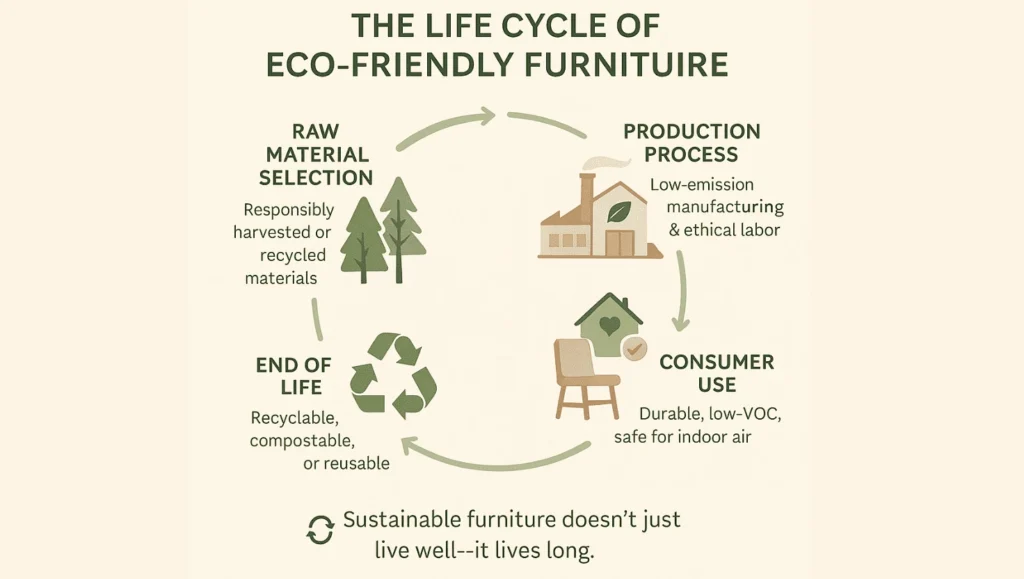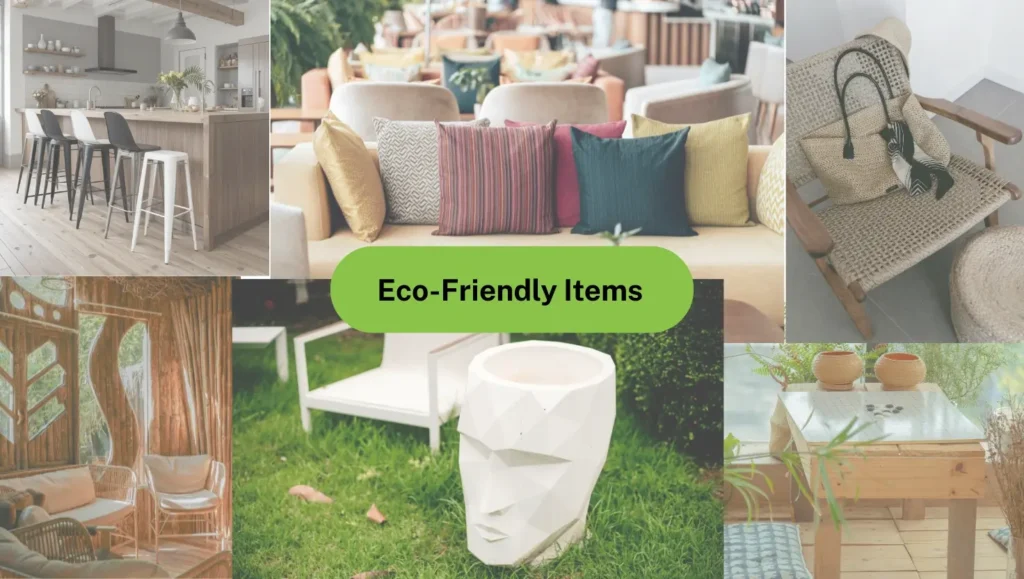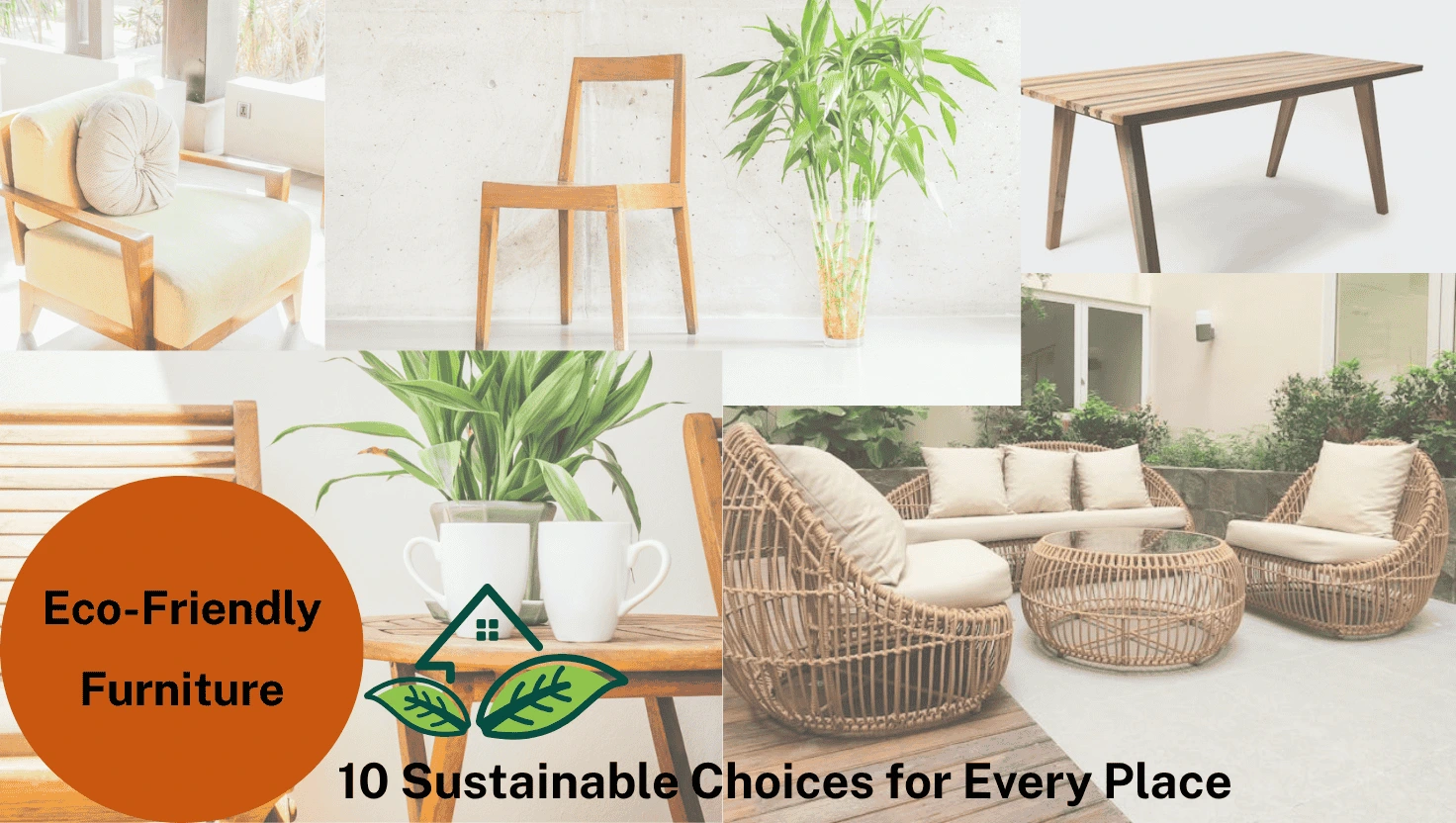Table of Contents
Introduction
In today’s design-loving world, choosing the right furniture is not just about aesthetics; it is about impact. Eco-friendly furniture has emerged as a thoughtful choice for homeowners who want their spaces to reflect not just style but sustainability as well. From responsibly sourced materials to non-toxic finishes, sustainable home furniture is changing the way we think about decorating our living spaces.
Why does it matter? Because every chair, table, or shelf you bring home has a footprint. Traditional furniture often involves deforestation, heavy carbon emissions, and harmful chemicals. By choosing sustainable home furniture, you are making a conscious decision to support the environment, protect your indoor air quality, and invest in long-lasting pieces, both in quality and design.
In this beginner-friendly guide, we will tell you what makes furniture truly eco-friendly, how to recognize sustainable options, and where to begin if you are starting your journey toward greener living. Whether you are decorating a new apartment or updating a room, this post is a starting point for you to make thoughtful choices that feel good and look great.
Let’s explore the world of eco-conscious decor, where every piece tells a greener story.
What Is Eco-Friendly Furniture?
When we talk about eco-friendly furniture, we refer to pieces designed with the planet in mind, from the raw materials used to the way they are produced, transported, and even discarded. It is a sustainable way to decorate your home that reduces environmental impact and promotes healthier living spaces.

Definition and Key Features of Eco-Friendly Furniture
Essentially, eco-friendly furniture, also known as sustainable home furniture, aims to minimise harm to the environment. It is crafted using responsible methods and materials, prioritising long-term durability over short-term trends.
Key features often include:
- Sustainable sourcing: Ingredients are harvested in ways that support ecosystem balance.
- Low environmental impact: The production process avoids toxic chemicals and excessive carbon emissions.
- Ethical craftsmanship: Many brands ensure fair labor practices and local sourcing.
- Recyclability or biodegradability: These products are designed to be reused, repurposed, or safely returned to nature.
In essence, it is furniture that looks good, feels good, and does good.
Commonly Used Sustainable Materials
One of the most important aspects of eco-friendly furniture design is the choice of materials. Here are some commonly used options:
- Reclaimed wood: Salvaged from old buildings, barns or furniture, reclaimed wood adds character while reducing the demand for new wood.
- Bamboo: A rapidly renewable resource, bamboo grows quickly without the need for pesticides, making it a favorite for modern, minimalist designs.
- Recycled metals and plastics: Upcycled metals and plastics provide industrial appeal while diverting waste from landfills.
- Cork and rattan: Lightweight, biodegradable and sustainably harvested, these materials bring an organic texture to the home.
- Natural fabrics: Think organic cotton, hemp, or linen for upholstery – materials that are grown without harmful chemicals and are safe for both people and the planet.
Choosing these materials helps reduce deforestation, reduce pollution, and support responsible farming and manufacturing practices.
Here is a quick comparison of popular eco-friendly materials and why they matter:
| Material | Why It is Eco-Friendly | Example Use |
|---|---|---|
| Reclaimed Wood | Reduces the need for new lumber; full of rustic character | Dining tables, shelves, headboards |
| Bamboo | Grows rapidly without pesticides; regenerates naturally | Chairs, flooring, bed frames |
| Recycled Metal | Prevents landfill waste; highly durable and recyclable | Table legs, frames, hardware |
| Organic Cotton | No synthetic pesticides or dyes; biodegradable | Cushions, sofas, upholstery |
| Rattan & Cork | Lightweight, renewable, and biodegradable | Accent chairs, stools, side tables |
| Recycled Plastic | Diverts waste from oceans and landfills | Outdoor furniture, molded chairs |
Note: Look for certifications like FSC (Forest Stewardship Council) for wood or GOTS for organic textiles to verify the sustainability claims.
Low-VOC Finishes and Non-Toxic Adhesives
Have you ever bought new furniture and noticed a strong chemical smell in your home? This is usually due to volatile organic compounds (VOCs), harmful chemicals found in many finishes, paints, and adhesives. Eco-friendly furniture avoids these altogether or uses low-VOC alternatives.
- Low-VOC finishes reduce emissions of toxins into the air, improving indoor air quality and reducing health risks.
- Water-based paints and sealants are increasingly being used in eco-friendly design of furniture due to their reduced impact on the environment.
- Non-toxic adhesives (such as soy-based or plant-based glues) replace traditional options that can release harmful fumes over time.
By focusing on these safer alternatives, sustainable furniture not only protects the environment but also promotes a cleaner, healthier home for you and your family.
Why Choose Sustainable Furniture?
When it comes to decorating our homes, the choices we make go beyond aesthetics. Sustainable furniture is not just a trend; it is a thoughtful investment in our planet, our health, and our wallets. Let’s find out why choosing eco-conscious furnishings makes so much sense.
Better for the Environment
Eco-friendly furniture is made using renewable or recycled materials, produced in low-impact ways that reduce emissions and minimize waste. By choosing these pieces, you’re helping to conserve natural resources and reduce your carbon footprint, one responsibly crafted table or chair at a time.
Healthier for You and Your Family
Traditional furniture can contain toxic chemicals like formaldehyde and flame retardants, which release harmful gases into the air inside your home. Sustainable options use non-toxic glues, natural fabrics, and low-VOC finishes, good news for anyone with allergies, asthma, or sensitivities to synthetic materials.
Smarter for Your Wallet Long-Term
While sustainable furniture may cost a little more upfront, it often outperforms mass-produced alternatives in terms of quality and longevity. These pieces are designed to be durable, timeless, and repairable, so you would not need to replace them anytime soon. Over time, this leads to real savings and less waste.
In short, sustainable furniture is an investment in your wellbeing, your wallet, and the world
How to Identify Eco-Friendly Furniture
Finding truly eco-friendly furniture can be tricky, but a little research goes a long way. Here is a simple guide that will help you make informed, conscious choices:
Certifications to Look For
Start by checking for credible environmental certifications. These labels are proof that the furniture meets strict sustainability standards:
- FSC (Forest Stewardship Council): Ensures wood is sourced from responsibly managed forests.
- Greenguard: Indicates low chemical emissions, which contribute to healthy indoor air.
- Cradle to Cradle: Certifies products that are safe, circular, and responsibly made from production to disposal.
These labels are more than just stamps; they are third-party verified, so you know you are not just trusting a brand’s word.
Questions to ask the retailer or brand
Don’t hesitate to ask questions , it shows you are an informed buyer:
- Where are the materials sourced from?
- Is the wood reclaimed or certified?
- Are non-toxic finishes and adhesives used?
- What is the expected lifespan of the product?
A transparent brand will be happy to answer these and may even proudly display the information.
Red flags to look out for
Unfortunately, greenwashing is common. Be careful if:
- The product uses vague terms like “eco” or “green” without proof.
- There is no mention of certification or material sourcing.
- It is made from low-cost synthetics like PVC or contains formaldehyde-based glue.
If something sounds too good to be true, especially at a suspiciously low price, it probably is.
Choosing sustainable furniture is not just about what looks good; it is about what does good. With a little awareness, you can create a beautiful space that also respects the environment.
10 Sustainable Furniture Choices You Will Love
Do you want to make your home stylish and sustainable? Then this is a great option for you. We have compiled a list of 10 sustainable home furniture options that blend beauty, functionality, and eco-responsibility. Whether you are redesigning a room or making a thoughtful change, these options will help you create a green home without compromising on style.
1. Reclaimed Wood Coffee Table
- Material: Wood salvaged from barns, factories, or shipping pallets
- Why you will love it: Each piece tells a story with its unique grain, texture, and imperfections.
- Ideal for: Living rooms that need a rustic or industrial touch
- Bonus: Brands like Urban Wood Goods specialize in custom reclaimed pieces.
2. Bamboo Bed Frame
- Material: Rapidly renewable bamboo
- Why you will love it: Bamboo is strong, stylish, and grows faster than traditional hardwoods.
- Ideal for: Minimalist or nature-inspired bedrooms
- Eco tip: Look for FSC-certified bamboo to ensure responsible sourcing.
3. Organic Cotton Upholstered Sofa
- Material: Organic cotton fabric, low-VOC foam and FSC wood frame
- Why you will love it: Soft on the planet and your skin – free of harmful chemicals.
- Ideal for: Family rooms or nurseries
- Recommended brand: Sabai offers customisable, non-toxic sofas built to last.
4. Cork Lounge Chair
- Material: Harvested cork (from regenerated bark)
- Why you will love it: Lightweight, hypoallergenic and pleasantly resilient to sit on
- Ideal for: Cozy reading corners or modern living spaces
- Fun fact: Cork harvesting does not require cutting down trees
5. FSC-certified dining set
- Material: Sustainably harvested wood from FSC-certified forests
- Why you will love it: Peace of mind knowing the wood is ethically sourced.
- Ideal for: Formal or informal dining spaces
- Trusted label: FSC (Forest Stewardship Council) is the gold standard in wood certification.
6. Recycled Metal Bar Stool
- Material: Repurposed aluminum or steel
- Why you will love it: Industrial charm with sustainability
- Ideal for: Kitchen island, home bar or loft
- Design note: Powder-coated finishes add color without any toxic chemicals.
7. Rattan Storage Basket
- Material: Natural rattan or cane
- Why you will love it: Lightweight, breathable and fully biodegradable
- Ideal for: Organizing toys, blankets, laundry or plants
- Tip: Choose handwoven pieces from artisan cooperatives to support fair trade.
8. Eco-friendly outdoor furniture sets
- Materials: Recycled plastic, teak alternatives and weather-resistant bamboo
- Why you will love it: Durable to the elements without harming the planet
- Ideal for: Patios, balconies or garden lounges
- Popular choice: Polywood makes stylish, recycled HDPE sets that last for decades.
Investing in eco-friendly outdoor furniture is a great way to extend your green lifestyle outside.
9. Modular furniture with replaceable parts
- Materials: A mix of FSC wood, metal and recyclable components
- Why you will love it: Designed to be repaired, not replaced
- Ideal for: Urban apartments or anyone who moves frequently
- Smart choice: Brands like Burrow and Campaign make modules that grow with your needs.
10. Second-hand or vintage furniture
- Material: Varies, often solid wood or metal
- Why you will love it: Timeless charm, no new materials, and often more affordable
- Ideal for: Any room needing a touch of character
- Where to look: Try local thrift shops, estate sales, or platforms like Chairish and Facebook Marketplace.

Comparison Table: Sustainable vs Traditional Furniture Materials
| Feature | Sustainable Furniture Materials | Traditional Furniture Materials |
|---|---|---|
| Source | Responsibly harvested or recycled (e.g., FSC-certified wood, reclaimed timber, bamboo) | Often from non-renewable or unsustainably harvested sources (e.g., mass-produced hardwood, tropical woods) |
| Environmental Impact | Low carbon footprint, promotes biodiversity, minimal waste | High environmental cost due to deforestation, pollution, and overconsumption |
| Toxicity | Free from VOCs, formaldehyde, and harmful chemicals | May contain toxic finishes, adhesives, and synthetic materials |
| Durability | Designed for longevity with repairable parts; often handcrafted | May be mass-produced with lower-quality materials, leading to shorter lifespan |
| End-of-Life | Biodegradable, recyclable, or upcyclable | Often ends up in landfills due to mixed materials and non-recyclability |
| Cost Over Time | Higher initial investment but cost-effective in the long run | Lower upfront cost but frequent replacements increase long-term expenses |
| Examples | Bamboo, reclaimed wood, cork, recycled metal, organic cotton | MDF, particleboard, PVC laminates, chemically treated wood, synthetic leather |
Read Also – 15 Affordable Eco-Friendly Home Decor Ideas in 2025
Where to Buy Eco-Friendly Furniture
Finding eco-friendly furniture is now simpler than ever, thanks to the increasing number of ethical retailers and innovative designs. Whether you are creating a new space or redecorating, here are some places to check out:
Online Retailers with Sustainable Collections
West Elm, Burrow, and Avocado are just a few of the major online retailers now featuring dedicated collections of sustainable furniture and home goods. These brands emphasize using FSC-certified wood, non-toxic paints and finishes, and ethical manufacturing methods. Many of their sites even have filters to help you easily find sustainable options without sacrificing style or comfort.
Local Artisans and Workshops
Buy furniture from local makers to lower your carbon footprint and get one-of-a-kind, handcrafted items. Many use recycled wood and sustainable materials, and local shopping cuts down on shipping emissions. It is also a great way to support local artisans and your community.
Second-Hand Marketplaces
Pre-owned furniture has a unique charm. Sites like OLX, Facebook Marketplace, and local thrift shops are full of amazing finds that just need a little TLC. Upcycling these pieces not only keeps them out of landfills but also lets you get creative and make them your own.
With every considered decision, you are not only improving your home but also contributing to a more sustainable future.
Eco-Friendly Furniture Design Tips for Beginners
Going green with your furniture does not mean sacrificing style or comfort. Simple changes can make a big difference. Here is how to create a more sustainable and stylish living space.
1. Combine sustainable items with your current home decor
Going green does not mean trashing everything. Gradually add sustainable furniture. Begin with a repurposed wood coffee table, a bamboo chair, or a hand-woven jute rug. These natural, earthy items add warmth and appeal while working with most decorating styles. The aim? A beautiful and sustainable home.
2. Opt for simple, multi-purpose furniture
Imagine clean lines, a tidy space, and pieces that serve more than one function. A storage bench, or a sofa bed, for example, maximizes usefulness while reducing clutter and waste. Minimalist design is not just stylish; it is a practical, eco-friendly choice that encourages mindful living and less reliance on material possessions.
3. Choose timeless styles with natural finishes
Forget fleeting trends and buy furniture that ages beautifully. Natural finishes like oiled wood, stone, or unpainted metal are durable and always in style. Plus, they minimize toxic coatings and help your furniture last longer.
These easy eco-friendly furniture design tips will help you build a beautiful, sustainable home, one smart decision at a time.
Common Myths About Eco-Friendly Furniture
“It is too expensive”, Not necessarily, Sustainable products might cost more initially, but their longevity often translates to significant long-term savings. And don’t forget the budget-friendly, eco-conscious choices available in secondhand and upcycled goods.
“It is hard to find stylish options”, Eco-friendly does not have to mean boring. From sleek Scandinavian designs to rustic reclaimed wood, sustainable furniture now blends beautifully with every decor style.
“It would not last long”, In contrast, quality eco-friendly furniture is made to last. Solid wood, natural finishes, and ethical craftsmanship often result in pieces that last longer than mass-produced alternatives.
Conclusion
Choosing eco-friendly furniture is more than a trend; it is about building a healthier home and contributing to a greener world. From the sustainably harvested wood to the enduring design, every piece you choose helps reduce waste and supports responsible production. Make a small, meaningful purchase this month that reflects your values and improves your living environment.
Ready to make a change?
👉 [Download our FREE Eco-Furniture Checklist]
👉 [Check out our top recommended sustainable brands] to begin your journey toward mindful, stylish living.
Read Also- Top 15 Eco-Friendly Home Decor Brands You Need to Know in 2025
Frequently Asked Questions (FAQs)
1. What makes furniture eco-friendly?
Eco-friendly furniture is made from sustainable, non-toxic materials such as FSC-certified wood, reclaimed timber, bamboo, or recycled metal. It’s produced through low-impact manufacturing processes and designed to last, reducing waste and carbon footprint.
2. Is sustainable furniture more expensive than regular furniture?
While the upfront cost can be slightly higher, eco-friendly furniture often lasts longer due to superior craftsmanship and materials. In the long term, it proves cost-effective and environmentally responsible.
3. Can eco-friendly furniture be stylish and modern?
Absolutely. Many sustainable brands today offer minimalist, chic, and contemporary designs that cater to a wide range of aesthetics. Style and sustainability now go hand in hand.
4. Where can I buy authentic eco-friendly furniture?
You can shop from dedicated sustainable furniture brands online, visit local artisan workshops, or explore second-hand platforms like thrift stores and vintage marketplaces that support reuse and upcycling.
5. How can I verify if furniture is truly sustainable?
Look for certifications such as FSC (Forest Stewardship Council), GREENGUARD, or OEKO-TEX. These labels ensure environmental and health safety standards in sourcing and manufacturing.
6. Can I mix sustainable pieces with my existing furniture?
Yes, In fact, blending eco-friendly pieces with what you already own is a smart and creative way to transition to a more sustainable home without waste or a complete overhaul.

